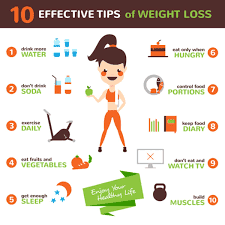Top 10 Tips to Lose Weight
A well-balanced diet and lifestyle are the secrets to healthy living and improved weight management. Some strategies for losing weight include keeping a diet and weight journal, exercising frequently, and seeking social support.
You may be more susceptible to major health issues including high blood pressure, heart disease, and type 2 diabetes if you are overweight.
It is imperative to make small, long-lasting, healthy lifestyle adjustments to lose weight safely and maintain that weight loss over time.
Ten Weight-Management Tips
Ten weight-management tips are offered in this article.
These include:
1. Eat varied, colorful, nutritionally dense foods:
The foundation of the human diet should consist of nutritious meals and snacks. Making sure every meal includes complete grains, protein, fruits, and veggies is an easy approach to making a meal plan. Consuming 25 to 30 grams (g) of total fiber per day is advised.
As trans fats are strongly linked to coronary heart disease, people should also try to cut out trans fats from their diet and consume fewer saturated fats.
As an alternative, people can eat unsaturated fats such as monounsaturated fatty acids or polyunsaturated fatty acids.
The foods listed below are nutrient-dense and wholesome:
- fresh fruits and vegetables
- fish
- legumes
- nuts
- seeds
- entire grains, including oatmeal and brown rice
Foods that reduce your intake include:
- foods with added oils, butter, and sugar
- fatty red or processed meats
- baked goods
- Processed foods low in nutrients, such as cookies or chips
Sometimes eliminating particular foods from the diet can result in a person becoming vitamin and mineral deficient. Advice on how to consume adequate nutrients while adhering to a weight loss plan can be obtained from a registered dietitian nutritionist (RDN).
2. Keep a food and weight diary:
One useful strategy for effectively losing weight is self-monitoring. Every meal that a person eats each day can be tracked using a paper diary, smartphone app, or special website. By keeping a weekly weight log, they can also track their development.
Sticking to a weight loss program is more likely for those who can recognize physical changes and measure their progress in tiny steps. If it becomes compulsive or detrimental to mental health, it is crucial to monitor the situation.
3. Exercise and physical activity regularly:
Exercise regularly is essential for mental and physical wellness. A controlled and intentional increase in physical activity frequency is frequently essential for effective weight loss.
Brisk walking is one of the 150 minutes of moderate-intensity daily activity that the American Heart Association (AHA) suggests doing each week.
It is possible to progressively increase the quantity and intensity of exercise for people who are not typically physically active. The most lasting method for making regular exercise a part of their routine is this one.
Similar to how food planning might mentally aid in weight loss, tracking physical activity may also be beneficial. As fitness increases, a variety of free smartphone apps can support users in maintaining their confidence, accountability, and motivation.
If someone who has never exercised before finds the idea of a full workout daunting, they can start by engaging in the following exercises to increase their level of fitness:
- taking the stairs
- raking leaves
- walking a dog
- gardening
- dancing
- playing outdoor games
- parking farther away from a building entrance
Before beginning an exercise program, those with a low risk of coronary heart disease are unlikely to need a medical evaluation.
However, for some people, especially those with diabetes, a previous medical evaluation could be advised. A healthcare expert can be consulted by anyone uncertain about safe exercise levels.
4. Eliminate liquid calories:
Drinking sugar-sweetened soda, tea, juice, or alcohol can be a daily source of hundreds of calories. These are referred to as “empty calories” since they add more energy content without providing any nutritional value.
A person can limit themselves to water or unsweetened tea and coffee unless they are consuming a smoothie in place of a meal. A fresh orange or lemon can be added to the water to add taste.
Don’t confuse thirst with hunger. A person can frequently quench their appetite between planned meal times by drinking some water.
5. Measure servings and control portions:
Consuming excessive amounts of any meal, particularly calorie-dense foods, can lead to weight gain.
For many persons without access to or unwillingness to utilize measurement devices, estimating portions is a practical and useful technique.
When dining out, it can be helpful to keep track of food intake using the following size comparisons:
- A fist is around one cup when it comes to measuring out amounts of fruits and vegetables.
- In terms of measuring amounts of grains like rice or pasta, a tennis ball is roughly equal to ½ cup.
- A deck of cards measures a portion of fish, poultry, or other meats and meat alternatives, and is roughly equal to three ounces.
- Any type of olive oil, nut butter, or salad dressing may be measured with one tablespoon, which is about the size of a thumb.
Although they are not precise, these measurements can assist people in controlling their food intake in situations where the proper equipment is not accessible.
6. Eat mindfully:
Being completely conscious of why, how, when, where, and what they consume is known as mindful eating, and it may be beneficial for many people.
People choosing healthier foods may result from their increased awareness of their bodies.
Attentive eaters concentrate on the flavor, strive to eat more slowly, and relish their food. A 20-minute meal duration enables the body to process all the satiety cues.
Since many “all-natural” or low-fat foods aren’t always healthful, it’s important to focus on feeling content rather than full after eating.
7. Stimulus and cue control:
Overeating can result from a variety of social and environmental variables. A candy bowl can be difficult for certain people to give to another person without grabbing a piece, and some people are more likely to overeat when watching television.
Knowing what can make someone want to nibble on empty calories can help them come up with strategies to change their habit and reduce these triggers.
8. Plan:
More substantial weight loss will come from stockpiling wholesome foods for planned meal planning. Healthy eating selections can also be made by preparing ahead of time by washing and peeling fruits and vegetables.
Reduce the quantity of overly processed desserts and snacks in the house and make sure you have the ingredients on hand for wholesome, simple meals. Making healthy food choices can be made easier and mindless eating can be reduced.
It could also be simpler to plan food choices for social gatherings or dining establishments.
9. Seek social support:
Accepting loved ones’ support is essential for a successful weight reduction journey.
Some may want to post their progress on social media, while others may want to invite friends or family to attend.
Other avenues of support may include:
- a positive social network
- group or individual counseling
- exercise clubs or partners
- employee-assistance programs at work
10. Stay positive:
Since weight loss is a gradual process, people may become disheartened if they do not lose weight as quickly as they had hoped.
Some days will be more difficult than others to stick to a weight reduction or maintenance program. For a weight-loss program to be successful, one must be persistent and not give up when changing oneself appears too tough.
By altering their workout routines or the overall quantity of calories they want to consume, some people may need to reset their objectives.
The key is to remain optimistic and consistent in your efforts to overcome the obstacles that stand in the way of effective weight loss.
Losing weight:
It is not necessary to adhere to a particular food plan to lose weight. Instead, to attain a negative energy balance, people might concentrate on eating foods high in nutrients and increasing their physical activity.
Losing weight is mostly dependent on cutting calories overall rather than changing the ratios of protein, fat, and carbs in the diet.
A weight management program that incorporates regular exercise and a nutritious diet is the best defense against regaining lost weight.
People who have a body mass index (BMI) of 30 or more and no health issues related to obesity may benefit from prescription weight-loss drugs. People with obesity-related illnesses and a BMI of 27 or higher may also benefit from them.
Medication should, however, only be used to assist with lifestyle changes. If a person’s BMI hits 40 or above and weight loss efforts fail, surgical therapy may be a possibility.
Summary:
Maintaining a healthy diet can aid with weight control. Regular exercise and maintaining a food and weight journal are two other strategies for weight loss.
After losing weight, it’s normal to gain it again, but it’s crucial to keep going. Although maintaining weight presents numerous difficulties, a person can stay on track by eating a healthy diet and exercising regularly.
The long-term adoption of lifestyle changes can help people lose weight and keep it off.
FAQs
What is the best way to lose weight?
The most effective weight loss strategy is consuming fewer calories from nutritious foods and increasing physical activity to attain a negative energy balance.
How can someone take weight loss seriously?
The Centers for Disease Control and Prevention (CDC) advises leading a lifestyle that incorporates stress reduction, frequent exercise, and healthy eating to help maintain a moderate weight.
References:
- Fnp, K. D. (2024, October 9). 10 tips for successful weight loss. https://www.medicalnewstoday.com/articles/303409
- Dhameliya, N. (2023, July 11). Top 12 Best Tips For Weight Loss in Obesity Disease. Samarpan Physiotherapy Clinic. https://samarpanphysioclinic.com/12-tips-for-weight-loss/




